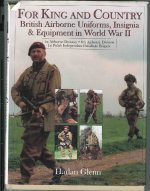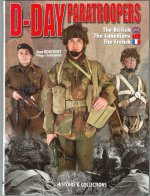Hi All,
Almost all mass produced camouflage fabric was printed. Some early examples of German Waffen SS camouflage such as Plane Tree were screen printed by hand, later converting to roller printing.
This type of monochromatic and polychromatic printing system debuted as early as 1809/10 with cotton fabrics. The concept is really very simple with the design repeating with the diameter of the roller. The repeating design simply registers at the beginning and the end.
This is very easy to see on most Waffen SS camouflage patterns such as Oak Leaf, but much harder to see on U.S. Herring bone twilled printed fabrics as used on the M1942 camouflaged uniforms.
Almost all of the fabrics start as a white or natural cotton or cotton/rayon in flat woven, twilled or herring bone twilled. The printing is then from light to dark, with the darkest colors being printed last. I should note that many, but not all fabrics were water repellent (to a very limited degree).
Finished yardage us then laid out and production cutting is done with various sized parts cut, bundled and then moved to production sewing. Little if any concern is made for print matching of the various panels, pockets, flaps, cuff, collars and other parts. In some examples you may even see slight tonal variations between rolls of fabric on the same garment.
In German camouflaged clothing it is not at all unusual to see two different camouflage patterns used on the same garment. I have owned at least two different Waffen SS Zeltbahns that had two different printed patterns on the same item.
The Dennison smock in most of its various war time and post war patterns consisted of a light green base over which were printed large irregular areas of dark green and chocolate brown. The brown, being lighter was almost always overprinted by the dark green, this often gives the impression of a fourth color. Parts of the printed design resemble fine lines giving the impression of wide brush strokes, no doubt inspired from the Heeres Splitter camouflage pattern introduced on the Zeltbahn 31.
So at the end of the day the most realistic figures will not have the camouflage pattern placement match from garment to garment, but the camouflage pattern itself will be consistent in size and shape. This should help put to rest any concerns about using the newer production painting with the older as the color variations will be historically more accurate.
What is less likely to happen, although I do this on the figures I paint for my own use, is the intentional miss matching of patterning between applied items of the garment such as pockets and major panel lines of construction. To do this forces you to actually look at a historical garment and understand how it was originally put together in a factory environment... I love this stuff.
Hope this helps a bit.. and my apologies to those of you that already know this,
Ken Osen
 A section of a splendid dio just posted of MG......a small point.....with all the fuss of the "P" extra cost for painting... will all the smocks have the same uniform cam pattern as per army issue...or will smocks have individual cam pattens as shown in picture.....a silly point maybe but for the collectors who like their TS accurate ,,,it is a point in MHO...cheers TomB
A section of a splendid dio just posted of MG......a small point.....with all the fuss of the "P" extra cost for painting... will all the smocks have the same uniform cam pattern as per army issue...or will smocks have individual cam pattens as shown in picture.....a silly point maybe but for the collectors who like their TS accurate ,,,it is a point in MHO...cheers TomB



